Bamboo masterworks
by Fujitsuka Shosei

Illustrated as cover and on pages 42 and 43
8
Uzushio (Whirling Waves) , 2012
Signed: Shosei made this Madake bamboo, rattan and lacquer
Height: 26.0cm
Width: 41.0cm
Depth: 41.0cm

by Fujitsuka Shosei

Illustrated as cover and on pages 42 and 43
8
Uzushio (Whirling Waves) , 2012
Signed: Shosei made this Madake bamboo, rattan and lacquer
Height: 26.0cm
Width: 41.0cm
Depth: 41.0cm
ISBN: 978 1 873609 57 6
Design, Typesetting and Photography Daniel M. Eskenazi
Printed and originated by Graphicom Srl., Vicenza © copyright 2025 ESKENAZI London
Bamboo masterworks by Fujitsuka Shosei
12 May - 4 July 2025
10 Clifford Street London W1S 2LJ
Telephone: 020 7493 5464
e-mail: gallery@eskenazi.co.uk
web: www.eskenazi.co.uk
序文
今 夏、藤塚松星氏の個展を開催 させていただけることを 大変光栄に思います。
今回展示される籠や彫刻の作品群は小規模ながらも多様性に富み、竹という素 朴な素材を芸術へと昇華させる藤塚氏の卓越した わざが感じ取れます 。竹を自 然のままに 用いたものから、細 い竹ひごを美しく染め上げ たものまで、それぞれ の作品は 驚くほどの精密さをもって制作されています 。藤塚氏が2023年に竹工 芸の分野で人間国宝に認定されたことは、その技術の高さを証明するもので あ り、人間国宝に選ばれた 竹 工芸 作家は、現在、藤塚氏を含めわずか3名 を数える のみです 。
4点の籠(カタログ番号2、3、4、6)は、藤塚氏が2003年に考案した 、細い三角 形の竹ひごを2色に染め上げて立体的に組み上げる独自の 技術によって制作さ れています。カタログの写真では 決まった視点 からの姿しか見えませんが、実際 には 鑑賞する角度によって 形状 や色 の見え方 が変化します。一方でカタログ番 号1、10は 、より竹そのものに近い作品となっています 。そして、この二つのスタ イル が 見事に融合されているのが、カタログ番号8、9の作品で あり、古典的な壺 の形に、竹の流麗な曲線が施されています。
このたび、藤塚氏がご自身の美しい作品を私たちに託し、また創作のインスピレ ーションについて短い 文章 を寄せてくださったことに、深く感謝申し上げます。ま た、本カタログに 詳細な解説 を執筆してくださった工芸史家であり、元 東京国立 近代美術館主任 研究員 で いらっしゃる諸山正則 氏にも、心より御礼申し上げま す。さらに、本展覧会のために尽力し、関係者間の調整を行ってくださった大口 雅美氏、翻訳を担当してくださったドゥオン 彩子氏、そして本カタログ制作にお いて多大な支援をしてくださったサラ・ウォン氏にも、深く感謝いたします。
ダニエル・エスケナージ
Foreword
We are honoured to host a solo exhibition by the celebrated bamboo artist Fujitsuka Shosei this summer. The small yet diverse group of baskets and sculptures reflect his prodigious skills that turn the humble material of bamboo into an art form. The pieces exhibit sublime precision whether the bamboo has been left in a natural state or crafted into very finely cut and dyed strips. It is no wonder that Mr Fujitsuka was designated in Japan as a Living National Treasure for Bamboo Crafts in 2023, a title only two other artists currently hold.
Four baskets (cat. nos. 2, 3, 4 and 6) use a remarkable technique Mr Fujitsuka pioneered in 2003 where the bamboo is cut into strips of triangular crosssection that are then dyed different colours. The images in the catalogue show one view but the shape and colour of the works change depending on the angle of the viewer. In contrast to these four are works where the bamboo has not been entirely cut into strips, as can be seen in cat. nos. 1 and 10. Joyful and somewhat bridging these two styles are cat. nos. 8 and 9 in which a classic jar shape is adorned by swirling patterns.
I would like to thank Mr Fujitsuka for entrusting us with his beautiful work and providing a short essay on his inspiration. I would also like to thank Moroyama Masanori, Craft Art Historian and former Chief Curator at the National Museum of Modern Art, Tokyo , who has kindly written a most infomative essay. I am indebted to Oguchi Masami who has greatly helped liaising between us all for this exhibition, Ayako Dehon for the translations and Sarah Wong for her support in the production of this catalogue.
Daniel Eskenazi
I am truly delighted to have the opportunity to present my work to the people of the United Kingdom here in London. I would also like to express my heartfelt gratitude and thanks to Daniel Eskenazi for making this possible.
The Japanese have long revered bamboo as a sacred plant inhabited by spirits, admired the beauty of bamboo groves and utilized bamboo as a material for various tools.
I create sculptural works using bamboo. This year marks my fifty-fourth year working with this material. In this exhibition, you will see works spanning a wide range of years, from my relatively early pieces to more recent ones. The materials also vary from sarashidake (bleached bamboo), susutake (smoked bamboo) and houbichiku (a type of bamboo with fine patterns). The colours are truly diverse – yellow, orange, brown, purple and green. Additionally, the techniques differ greatly depending on the work.
Notably, my recent works using the sai-henka (colour transformation) technique, which I newly developed using triangular strips ( higo ), are characterized by the intriguing visual effect in which the colours and patterns change depending on the viewing angle.
Through my works, I hope you enjoy the various sculptural beauties that bamboo, as a material, has brought into being.
Fujitsuka Shosei ステートメント
この度、ロンドンの地に於いて英国の方々に私の作品を見て頂けますことを大変 嬉しく思っております。そして、その機会を与えて下さったエスケナージさんに心よ り感謝を申し上げます。ありがとうござました。
さて、日本人は昔から竹を精霊が宿る神聖な植物として敬い、竹林の美しさを愛 で、様々な道具の素材として活用してきました。
私は、その竹で造形作品を制作しています。私は竹の仕事を始めて今年で54年 になりますが、今回は比較的初期の作品から近年の作まで、幅広い年代の作品を ご覧頂けます。と同時に、素材も晒竹、煤竹、鳳尾竹と様々ですし、色彩も黄、オレ ンジ、茶、紫、緑と実に様々です。また技法も作品によって大きく異なります。特に、 近年私が新たに開発した三角ヒゴによる「彩変化」と言う技法の作品は、見る角 度によって色と文様が変化する面白さが特徴の作品です。
どうぞ私の作品を通して、竹と言う素材が作り出す様々な造形美をお楽しみくだ さい。
藤塚松星
1949 Born in Hokkaido, Japan
1972 Studied under bamboo artist Shodo Baba
1973 Kanagawa Prefecture Art Exhibition, Kanagawa, Japan
1992 Encouragement Award, The 15th Japan Traditional Craft Arts , New Work Exhibition
1993 Governor of Tokyo Award, The 40th Japan Traditional Craft Arts Exhibition
1994 Commissioner of the Agency for Cultural Affairs Award, The 6th Japan Traditional Craft Arts Wood and Bamboo Exhibition
2002 Finalist for Cotsen Bamboo Prize 2002
2004 Part time instructor, Tokyo University of the Arts, Japan
2006 Beyond Basketry , The Museum of Fine Arts, Boston, USA Joined Successor Development Programme for Important Intangible Cultural Property (Bamboo Crafts)
2007-14 Contemporary Japanese Crafts , organized by Japan Foundation. Mershikov Palace, Russia; Museum of Far Eastern Antiquities, Sweden; The National Art Museum of the Republic of Belarus, Belarus; Brunei Museum, Brunei; Bangkok Art and Culture Centre, Thailand; Museum of Decorative Arts, Cuba; National Museum, Georgia; Instituto Giapponese de Cultura, Italy; and 32 more venues
2008 New Bamboo: Contemporary Japanese Masters , Japan Society, New York, USA
2009 MOA Museum of Art Award, The 49th Japan Traditional Craft Arts Exhibition , Eastern Division
2011 Governor of Tokyo Award, The 58th Japan Traditional Craft Arts Exhibition
2012 Received the Medal with Purple Ribbon
2013 Fired Earth, Woven Bamboo: Contemporary Japanese Ceramics and Bamboo Art , The Museum of Fine Arts, Boston, USA
2013 From Crafts to Kogei in Commemoration of the 60th Japan Traditional Art Crafts Exhibition , The National Museum of Modern Art, Tokyo, Japan
2014 The 19th MOA Okada Mokichi Award Exhibition , MOA Museum of Art, Shizuoka, Japan
2017 Japan Art Craft Association Award, Japan Traditional Craft Arts Exhibition, Eastern Division Minister of Education, Culture, Sports, Science and Technology Award, The 16th Japan Traditional Craft Arts Wood and Bamboo Exhibition
2017-18 Japanese Bamboo Art: The Abbey Collection , The Metropolitan Museum of Art, New York, USA
2019 Grand Prize, The 39th Pola Traditional Culture Award
2019-20 Japanese Bamboo Art from New York: The Abbey Collection. Gifts to The Metropolitan Museum of Art , Oita Prefectural Art Museum; The National Museum of Modern Art; Tokyo Crafts Gallery; The Museum of Oriental Ceramics, Osaka, Japan
2023 Designated a Living National Treasure in Bamboo Crafts
The National Museum of Modern Art, Tokyo, Japan
The Agency for Cultural Affairs in Japan
The Japan Foundation, Japan
MOA Museum of Art, Atami, Japan
The Hiratsuka Museum of Art, Hiratsuka, Japan
The Metropolitan Museum of Art, New York, USA
The Museum of Fine Arts, Boston, USA
Philadelphia Museum of Art, Philadelphia, USA
Asian Art Museum, San Francisco, USA
Fujitsuka Shosei’s Bamboo Craft – A New Tradition
Moroyama Masanori (Craft Art Historian, Former Chief Curator at the National Museum of Modern Art, Tokyo)
In 1999, Lloyd E. Cotsen of Los Angeles, held an exhibition, Bamboo Masterworks, in New York, with carefully selected masterpieces of bamboo flower baskets from his vast collection of Japanese bamboo works. This exhibition then toured various American cities to great acclaim and triggered a significant interest in bamboo craft, with an accompanying enthusiasm for collecting that spread from within the USA to Europe. While Japan was still astonished by this surge in appreciation, the recognition of bamboo craft as an art form rapidly gained international acceptance.
Following this, Mr Cotsen established the Cotsen Bamboo Prize to encourage emerging bamboo artists, holding the competition annually. It was Fujitsuka Shosei who won the runner-up prize at its second iteration in 2002. This achievement, along with further opportunities to showcase his work in the USA and other countries abroad, may have led him to develop a confidence in his own creative pursuits.
Japanese bamboo craftsmanship traditionally involves preparing round bamboo stems or splitting them into sections to make round or thin flat strips, which are then woven into various forms to create everyday household objects. From the mid-Meiji period onward, basket makers with exceptional skills ( kagoshi ) began using innovative techniques to produce artistic bamboo works for aesthetic appreciation, passing down their expertise through generations into the modern era.
Artists such as Iizuka Rokansai, Shono Shounsai and Tanabe Chikuunsai II revolutionized bamboo art by integrating a modern sense of self, highlighting the natural beauty and special characteristics of bamboo and developing unique weaving and structural techniques that transformed bamboo craft into contemporary art.
Artists who have been designated as Living National Treasures work to preserve the techniques and artistry of Japan’s finest traditional crafts. Thanks to them, the Japan Traditional Kogei Exhibition has been held continuously to the present day. Following in the footsteps of Living National Treasures such as Shono Shounsai and Iizuka Shokansai, many artists have set out to create new traditions suited to the times, exercising modern sensibilities and distinctive methods.
Fujitsuka’s rise as a leading contemporary bamboo artist was achieved through his mastery of openwork twill plaiting ( sukashi ajiro ami ) and his unique colourtransformation techniques ( sai-henka ), which earned him awards at the Japan Traditional Kogei Exhibition. In 2023, he was officially designated as a Living National Treasure in Bamboo Craft.
Fujitsuka’s work, Jomon Flower Basket (2011, the collection of the National Museum of Modern Art, Tokyo), with its openwork ajiro plaiting, was inspired by flame-shaped pottery from the Jomon period. This exquisitely woven flower basket features an outward-flaring rim reminiscent of morning glory flowers. The bulging body, plaited in ajiro style with thin, fine, black-dyed bamboo strips, is interspersed with bright red strips that evoke the flickering movement of flames bursting forth and crossing in arcs. While ajiro plaiting is one of the most basic traditional techniques, Fujitsuka introduced deliberate gaps in the weave to create openwork, meticulously adjusting them to produce a rich fullness. This required both the artist’s creativity and structural mastery and revealed his aesthetic sensibility.
Hoshifuruyoruni (Falling Stars) Flower Basket (2022), also employs openwork ajiro plaiting, creating a gently spreading bowl shape that undulates in three directions at the rim. It vividly evokes purple-lit shooting stars streaking across the celestial nebulae. The sharp contrast of black and purple bamboo strands exemplifies purity and displays Fujitsuka’s refined design sensibility.
Traditionally, bamboo craftsmen primarily utilize natural white bamboo, smoked bamboo ( susutake ) and antiqued or lacquered finishes. Sometimes they dye bamboo strips black or brown to enhance its natural beauty. However, Fujitsuka developed a ground-breaking sai-henka (colour transformation) technique. It involves splitting round bamboo stems into thin square strips, dyeing them black, and then beveling them into isosceles triangles. The two diagonal faces are dyed in different colours — black, purple or brown — and arranged in many fine lines to form belt-like or geometric shapes, or irregularly shaped sculptures. He also invented an original technique to reconstruct these sculptures from the initially conceived form, into the threedimensional structure of a flower basket. By changing the viewing angle, the glossy colours of black and purple produce an optical illusion: gradations or dramatic changes of colour.
His award-winning work at the 2009 Japan Traditional Kogei Exhibition, Amanogawa ( Milky Way ) Flower Basket , exemplifies this technique. This oval, boat-shaped flower basket with both ends raised, features an elegant interplay of deep purple and shadowy black. The colour transformation of elegant purple and shadowy black might appear fantastical, but it reflects the mysterious transformations of vivid light radiating in the celestial nebula, shifting from purple to black or black to purple as the viewpoint changes.
Tide 19 (2019) displays a gradation from bright brown to darkness, reflecting ocean waves under moonlight. Similarly, Shifting Colour Offering Tray 21 (2021) creates a striking yellow and black inversion effect in the bottom interior of the basket.
In addition, Chikusei-eno-dokei ( Longing for Green Bamboo ) (2022) consists of geometric surfaces of triangles and wedge shapes formed by connecting bamboo strips dyed in two colours — black and green — reflecting the freshness of green bamboo. These surfaces are divided and assembled in two tiers, left and right or diagonally up and down, creating a diamond-shaped boat-form basket. The black and vivid green are emphasized, intuitively suggesting the beauty of bamboo, but Fujitsuka’s creativity also evokes the spectrum of shining green light colouring the celestial nebulae within the constructed form.
Fujitsuka Shosei, true to his own vision, has repeatedly portrayed the dramatic galactic spirals and undulating nebulae unfolding in the profundity of the universe — his unique source of beauty, along with the unfurling of flowers and swirling tides. Furthermore, in both his openwork ajiro plaited works, which elegantly harmonize black and brown and in his colour-transforming forms coordinating black with purple or green, Fujitsuka is consciously expanding the tradition of modern bamboo art, capturing a new sense of beauty that transcends nature — to create what could be called a contemporary romantic form.
藤塚松星の竹工芸 新たな伝統
諸山正則(工芸史家 、元東京国立近代美術館主任研究員)
1999年にロサンゼルスのロイド・E.コッツェン 氏が膨大な日本の竹工芸コレクション から厳選した花籠の名品をニューヨークで公開し(“Bamboo Masterworks”展)、 さらにアメリカ各都市を巡回させて大好評を博した。これを契機に竹工芸への関心が 大いに高まり、その収集熱もアメリカ国内からヨーロッパへと伝搬し、日本国内が驚愕 している間に芸術としての評価が一気に国際的なスタンダードとなった。続けてコッツ ェン氏は、コッツェン・バンブー賞を創設して気鋭の竹工芸作家を奨励する活動を毎年 繰り広げた。その第2回目の2002年に準グランプリを受賞したのが藤塚松星で、その 後にアメリカほか国外での作品発表の機会も重ねて、彼は自らの創作への確信を自覚 するに至ったのではないか。
日本の竹工は、竹材を丸竹もしくは小割りし薄く細い平ひごや丸ひごを下拵えし、さま ざまに編み組み上げて暮らしの生活道具がつくられてきた。日本の明治中期頃以降、創 意工夫して卓越のわざを持った籠師らは鑑賞に供される美術工芸の制作を目指し、伝 統の系譜を脈々と近代に伝えた。そして飯塚琅玕斎や生野祥雲斎、二代田辺竹雲斎ら は、近代的な自我を獲得し、竹の美質や特質を個性的に活用した主題と独創の編組や 造形の表現を獲得して現代の芸術へと革新した。
日本の優れた伝統工芸のわざとその芸術を保持する重要無形文化財保持者が中心と なり、今日まで連綿と日本伝統工芸展は開催され続けてきた。保持者の生野祥雲斎と 飯塚小玕斎に続いた多くの作家らが時代に即した新しい伝統の創造を企図し、現代の 感性と個性的手法を発揮して発展させた。伝統のわざを多様に揮う藤塚松星が現代を 代表する作家として台頭したのは、主たる活動の場とした日本伝統工芸展で受賞を果 たした伝統の透かし網代編みと独創の彩変化の手法による制作であった。そして 2023 年 、藤塚松星は重要無形文化財「竹工芸」保持者に認定された。
透かし網代編みの《緋襷文花籃 縄文》(2011、東京国立近代美術館蔵)は、縄文時代 の尖底形の火焔土器を創意として、卓越した精細な編みの花籃で、口縁部を外側に反 らせた朝顔形となっている。黒染の薄く細い竹ひごで網代に編まれた膨らみの胴には何 本もの緋色のひごが挿入され、それはほとばしる炎が弧を描き交差する様が表されてい た。網代編みはもっとも基本的な伝統の手法であるが、編み目を少しづつ広げて透かし をつくり丹念に編みあげて豊かな膨らみを生み出す。そこには作家の主題の創意とそれ を確実にする造形力が肝要であり、直截に美の感性が現れる。《透かし網代編花籃 星 降る夜に》(2020)も透かし網代編みでゆるやかに広がり口縁部の三方で波打つ盛鉢 形に造形化されており、天空の星雲が揺らぐなか、紫に輝く流星がつくる情景が鮮やか な表現となっている。黒と紫の竹編みの清冽さと洗練されたデザイン性が明快である。
竹工は、清爽の白竹か煤竹、古色づけや漆塗りの仕上げを通常とし、ときには黒や褐色 に竹ひごを染めて天然の美しさに迫ろうとしてきた。藤塚松星が創作した彩変化は、丸 竹を小割りした細い四角ひごを黒く染め、それを面取りして二等辺三角形とする。その 斜めの両面を黒い色味と紫や褐色などに染め分け、それを千筋に連ねて帯様や幾何学 的な図形、または不定形の面体とする。当初に構想した形体を分割したその面体を花籃 の立体に再構成するという独創の技法とした。作品を見る角度を動かすことで黒と紫な どの彩りの光沢がグラデーションを生み、あるいは劇的に変化してイリュージョンを現 す。2009年の日本伝統工芸展の受賞作《彩変化花籃 天の河》は、楕円形で両端が持 ち上がった船形の花籃である。気品のある紫と陰の黒という彩変化は奇想と映ったかも しれないが、天空の星雲に溢れる鮮やかな光が紫から黒へ、あるいは黒から紫へと視点 の移行にあわせて幽玄な変幻を映していた。
《彩変化花籃 潮 ‘19》( 2019 )は月夜の波浪が映じた明るい褐色から暗みへとグラ
デーションを描き、《彩変化盛器 ‘21》( 2021 )は盛器の見込みを分割した黄と黒の面 が劇的に反転する。また《彩変化花器 竹青への憧憬》( 2022 )も、黒と青竹の瑞々しさ に映る緑の二色に染め分けた竹ひごを連ねた三角形やクサビ形の幾何学的な面体が 分割され、左右や斜角上下 2段 に組まれて菱形の船形花籃となっている。黒と鮮烈な緑 が強調され、それは竹の美質を直観させるが、藤塚の創意は構成された造形のうちに 天空の星雲が彩る緑に輝く光の位相こそを想起させる。
藤塚松星は、自らの思いに徹して、花が開く形や渦巻く潮とともに、再々、独自の美の源 泉である深遠な宇宙に繰り広げられる銀河の渦や星雲の揺らぎをドラマチックな情景 としてきた。さらに言えば、透かし網代編みを基調にした編みの黒と褐色のハーモニー の端正な演出も黒と紫や緑とが協調した彩変化が彩る造形も、近代竹芸の伝統の拡張 を意識しつつ、自然を超越した新たな感覚の美を捉える、いうなら現代の浪漫的な造形 としている。
1
Enso Flower Basket, 2006
Signed: Made by Shosei
Susutake bamboo, rattan and lacquer
Height: 35.0cm
Width: 56.0cm
Depth: 23.0cm




2
Hoshifuruyoruni ( Falling Stars ), 2020
Signed: Made by Shosei
Madake bamboo, rattan and lacquer
Height: 14.5cm
Width: 38.5cm
Depth: 38.5cm
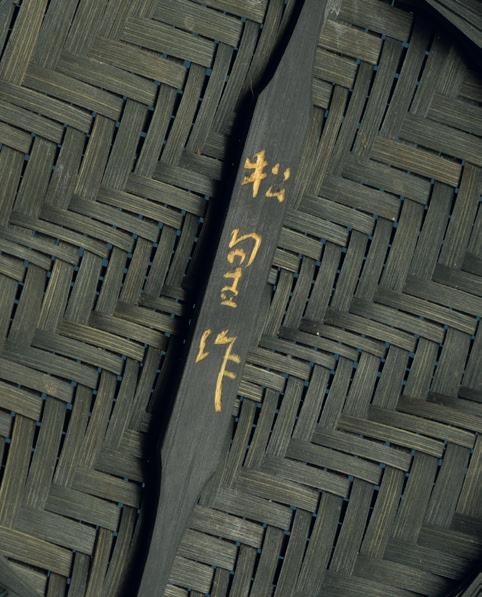
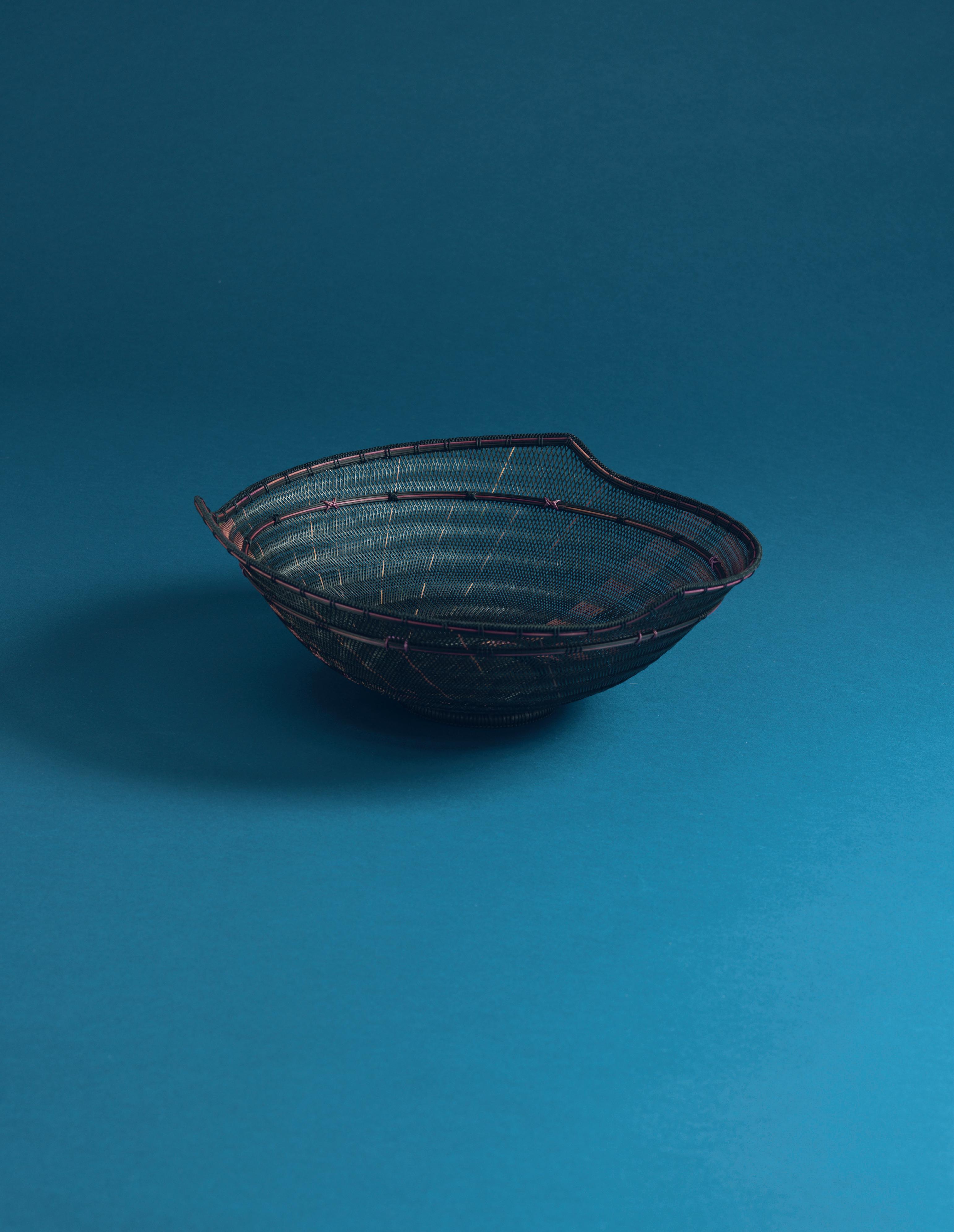
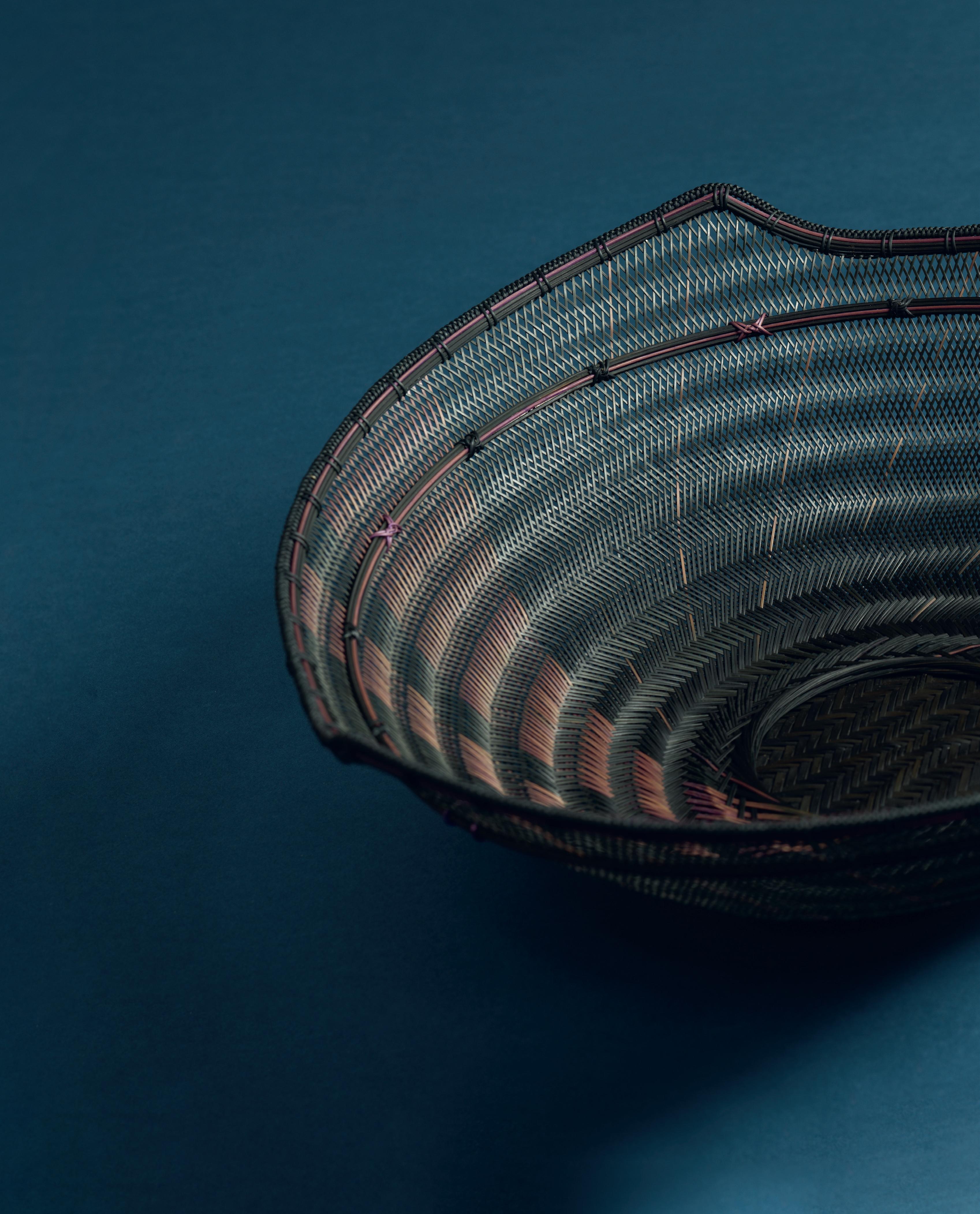

3
Saihenge-moriki 21 ( Shifting Colours Offering Tray 21 ), 2021
Signed: Made by Shosei
Madake bamboo, rattan and lacquer
Height: 8.5cm
Width: 36.0cm
Depth: 36cm




4
Chikuseihenodoukei ( Longing for Green Bamboo ), 2022
Signed: Made by Shosei
Madake bamboo, rattan and lacquer
Height: 50.0cm
Width: 16.0cm





5
Habataku ( Spreading Wings ), 1979
Madake
Height: 85.0cm
Width: 60.0cm
Depth: 68.0cm


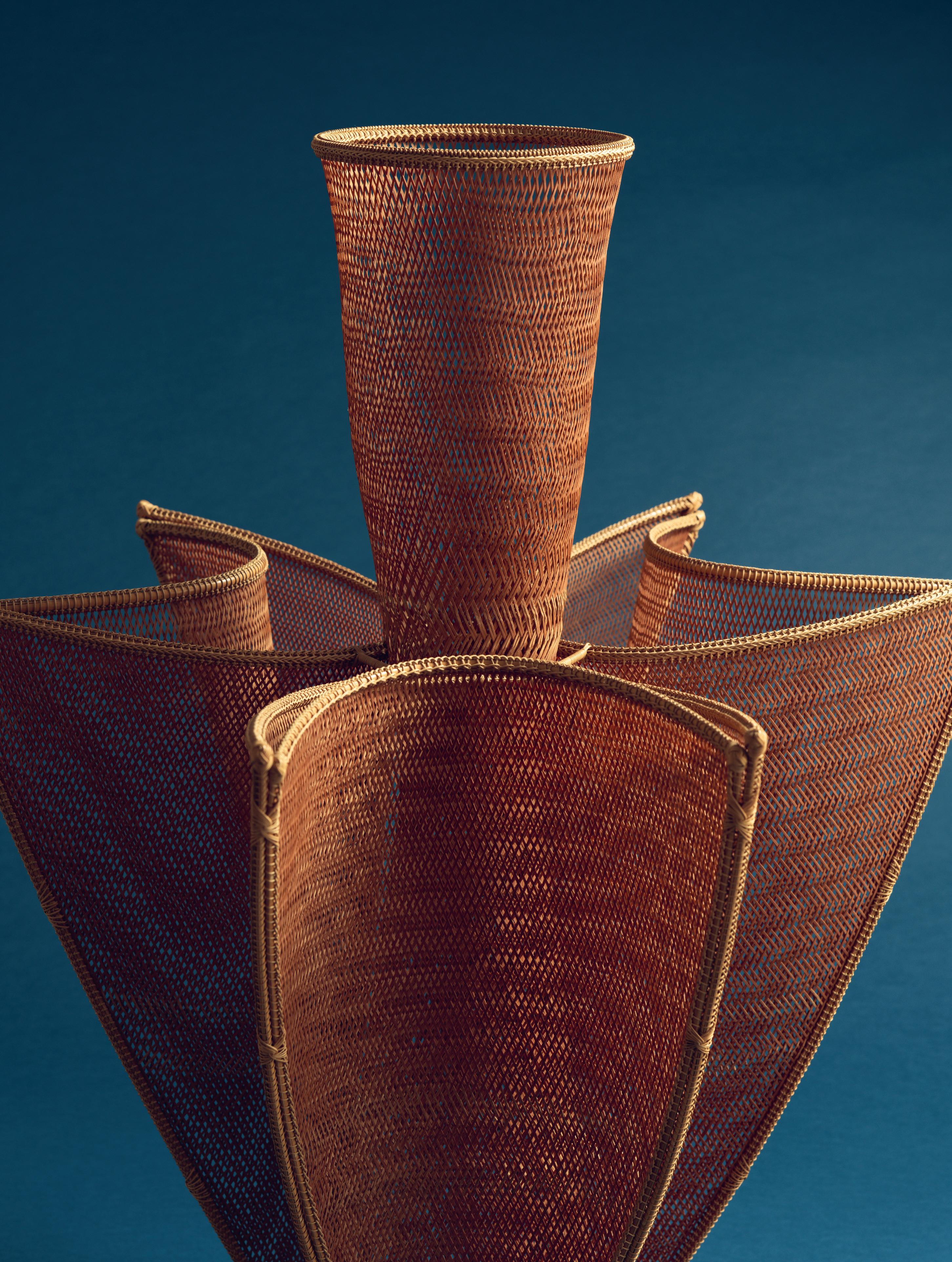
6
Ushio 19 ( Tide 19 ), 2019
Signed: Made by Shosei
Madake bamboo, rattan and lacquer
Height: 28.0cm
Width: 35.0cm
Depth: 33.0cm

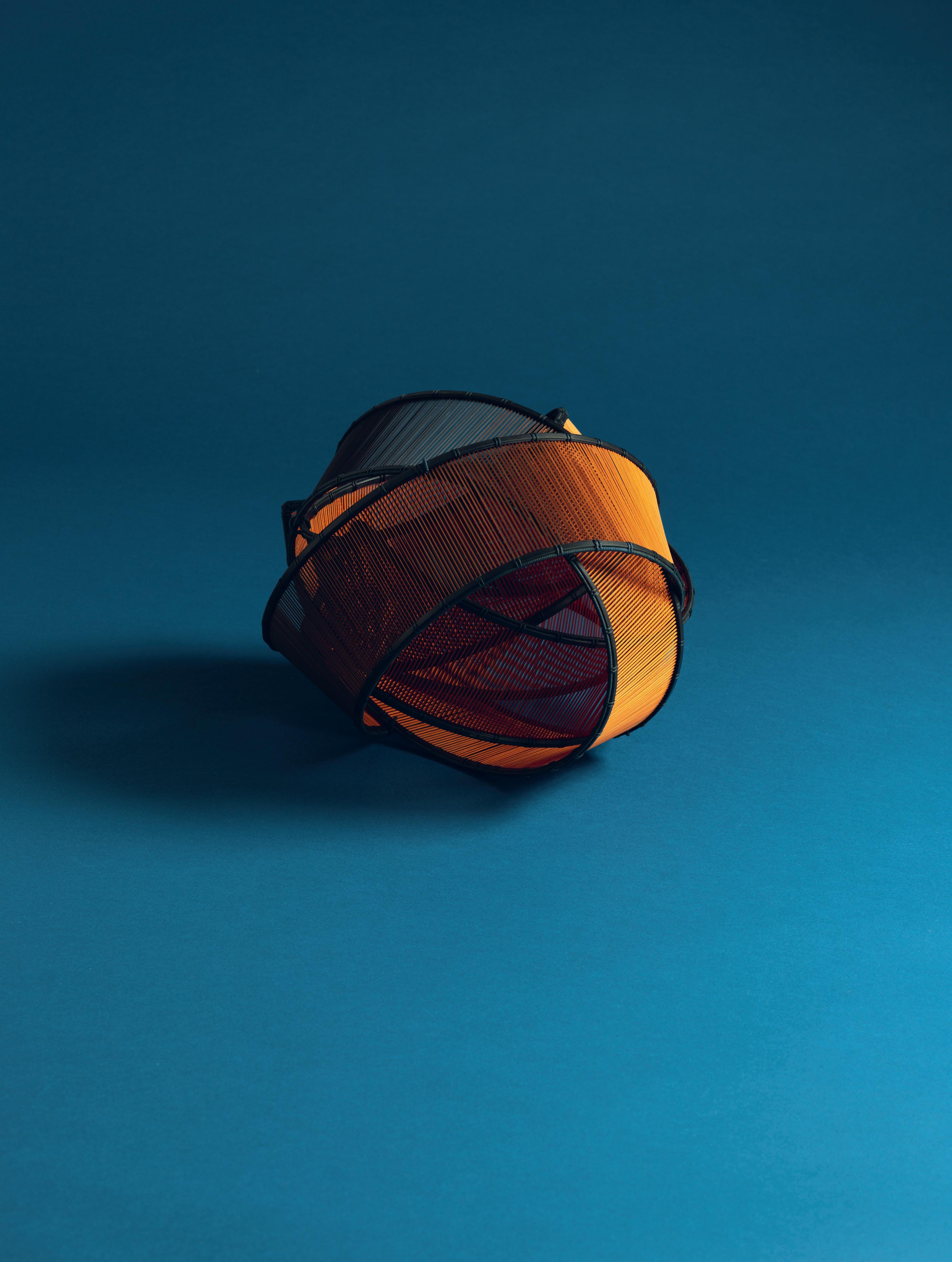
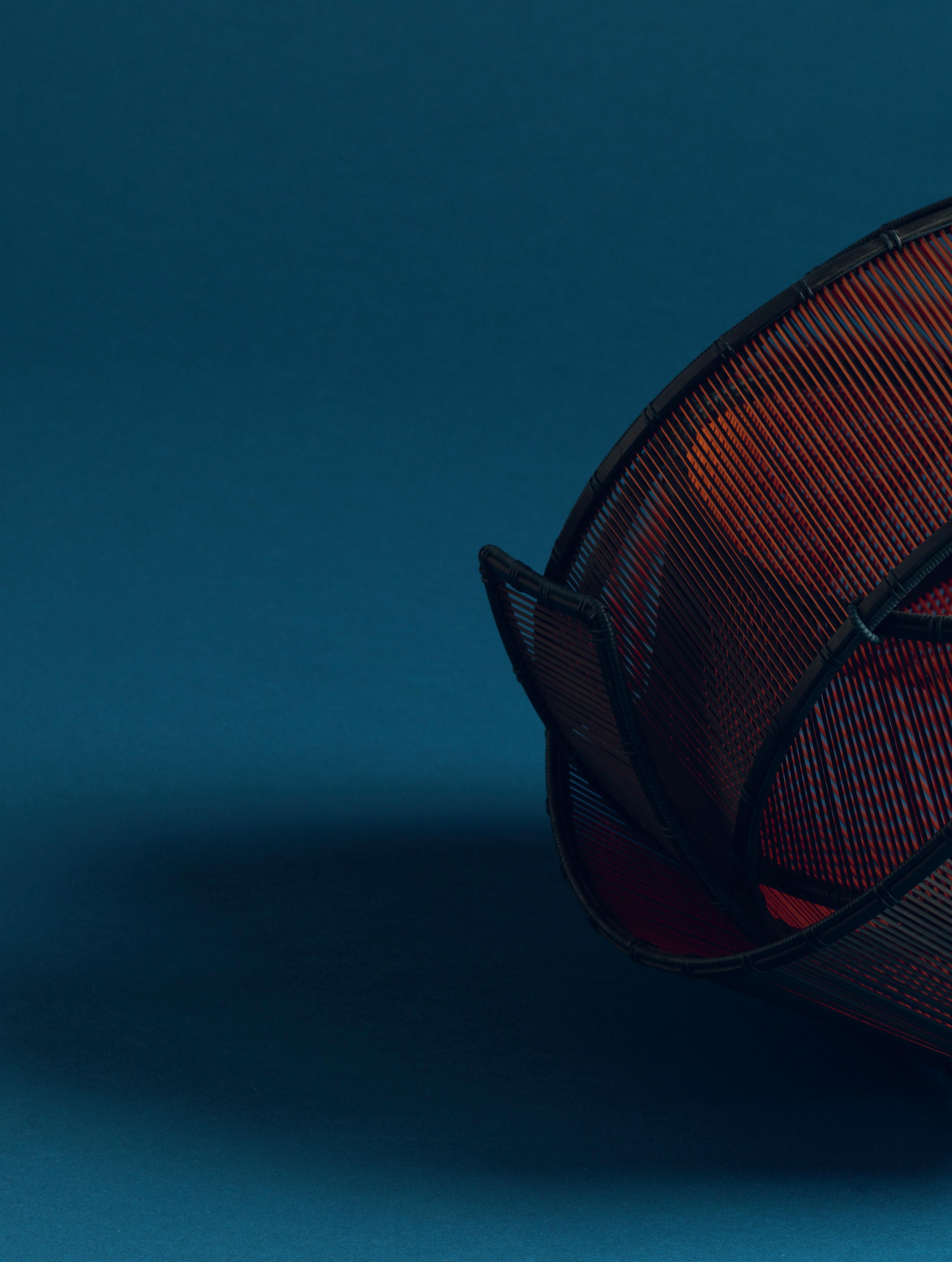

7
Uneri ( Swell ) Flower Basket, 1999
Signed: Made by Shosei
Madake bamboo
Height: 49.0cm
Width: 65.0cm
Depth: 47.0cm
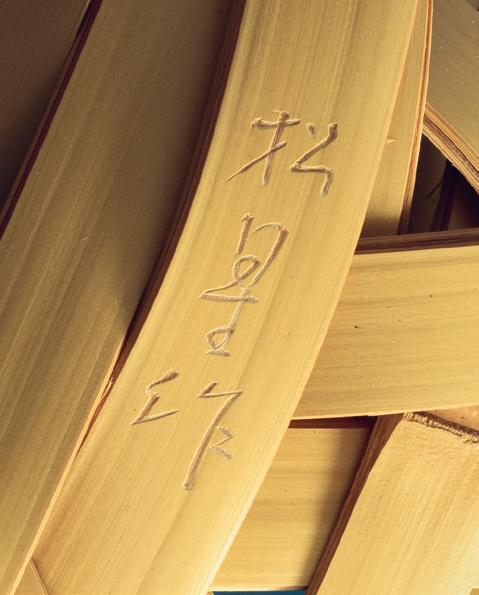



8
Uzushio ( Whirling Waves ), 2012
Signed: Made by Shosei
Madake bamboo, rattan and lacquer
Height: 26.0cm
Width: 41.0cm
Depth: 41.0cm


Fumon ( Wind-Wrought Pattern ), 2012
Signed: Made by Shosei
Madake bamboo and rattan
Height: 25.0cm
Width: 42.0cm
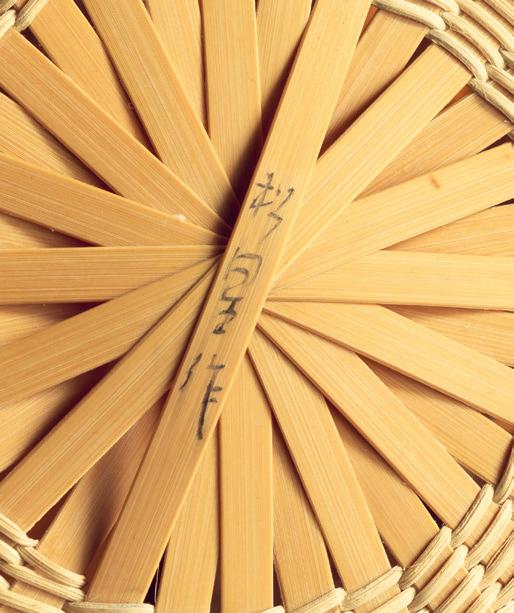
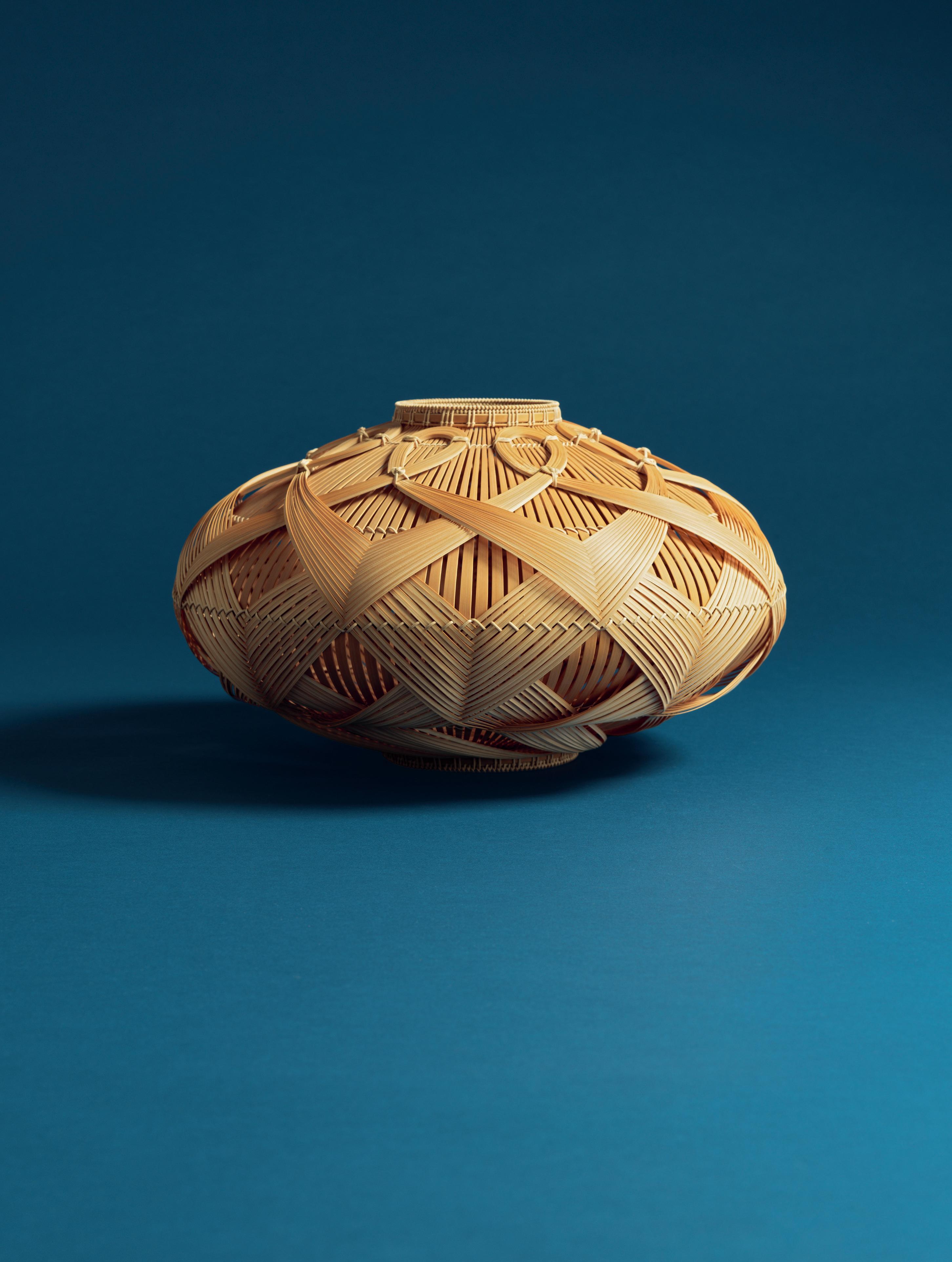
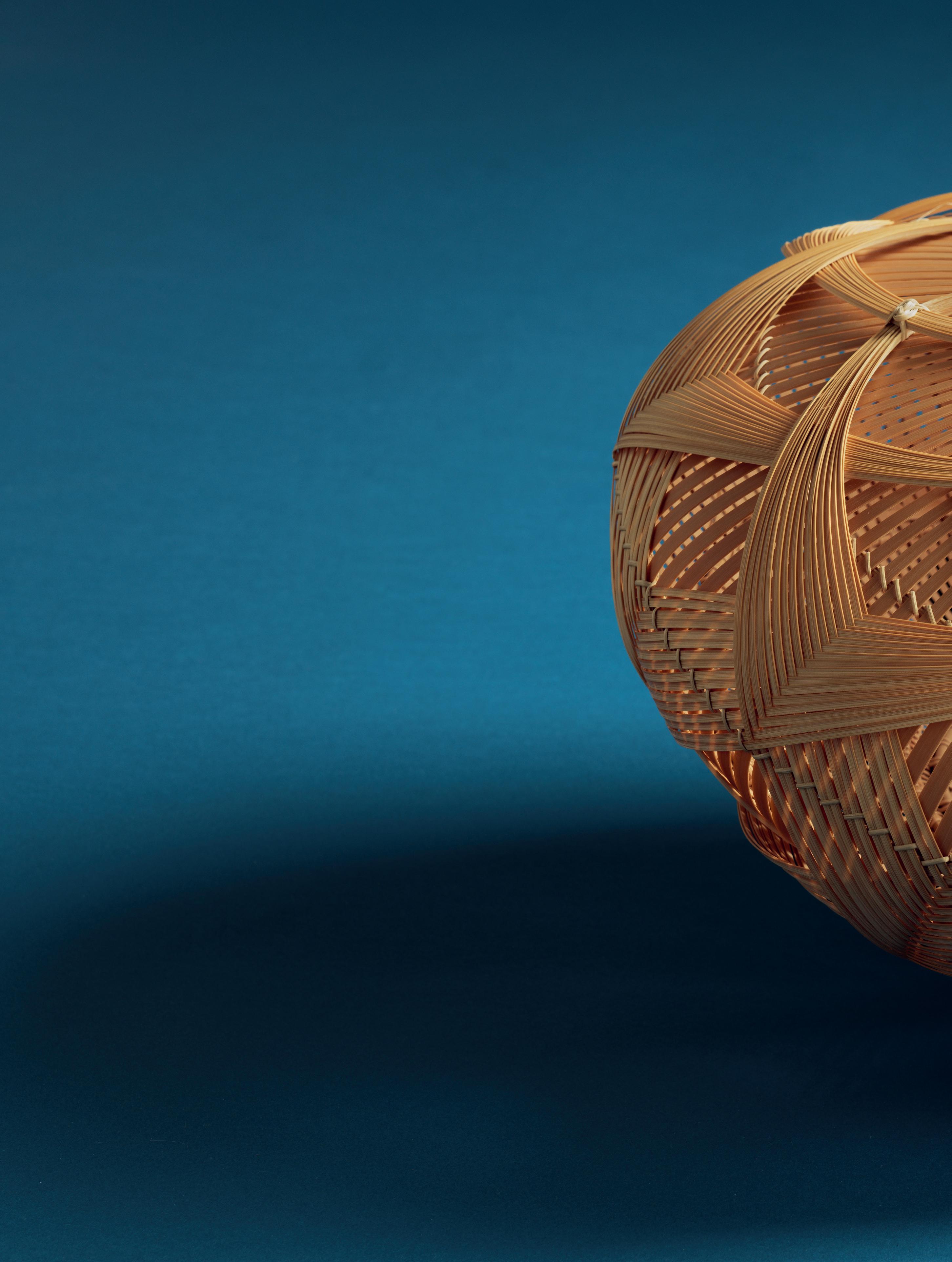

10
Morinosei
Susutake
Height: 136.0cm
Width: 54.0cm
Depth: 43.0cm

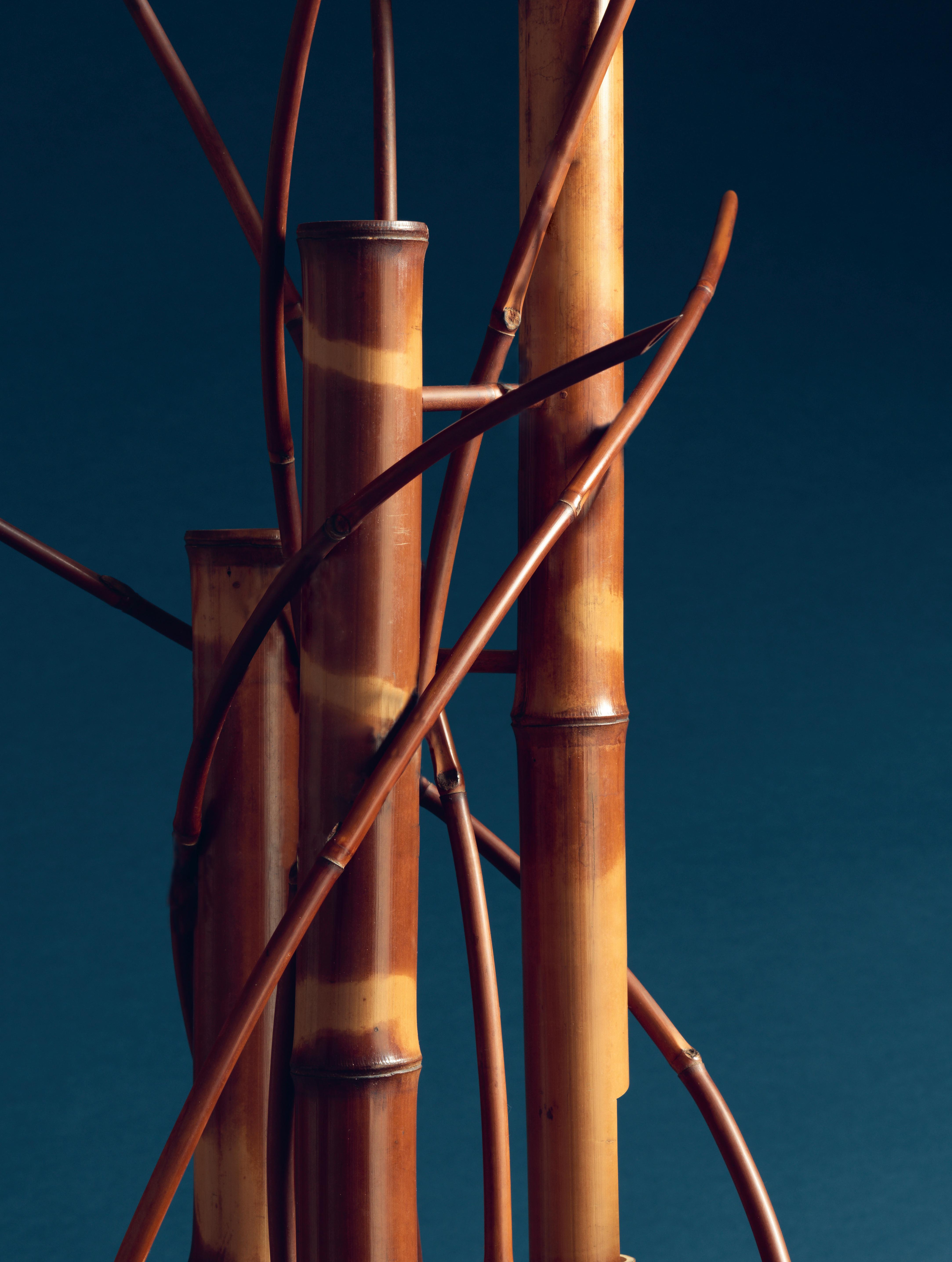

Works of art purchased from Eskenazi Ltd.
London, are now in the following museum collections:
Ackland Art Museum, North Carolina
Arita Porcelain Park Museum, Saga
Art Gallery of New South Wales, Sydney
Art Gallery of South Australia, Adelaide
Art Institute of Chicago, Chicago
Arthur M. Sackler Gallery, Washington, DC
Ashmolean Museum, Oxford
Asia House, Mr and Mrs John D Rockefeller 3rd Collection, New York
Asian Art Museum of San Francisco, San Francisco
Asian Civilisations Museum, Singapore
Baltimore Museum of Art, Baltimore
Birmingham Museum of Art, Alabama
British Museum, London
Brooklyn Museum, New York
Chang Foundation, Taibei
Chung Young Yang Embroidery Museum, Sookmyung Women’s University, Seoul, Korea
Cincinnati Art Museum, Cincinnati
Cleveland Museum of Art, Cleveland
Columbus Museum of Art, Columbus
Corning Museum of Glass, Corning
Dallas Museum of Art, Dallas
Dayton Art Institute, Dayton
Denver Art Museum, Denver
Designmuseum Danmark, Copenhagen
Didrichsen Art Museum, Helsinki
Fitzwilliam Museum, Cambridge
Flagstaff House Museum of Teaware, Hong Kong
Freer Gallery of Art, Washington, DC
Hagi Uragami Museum, Hagi
Hakone Museum of Art, Hakone
Harvard Art Museums, Cambridge, Massachusetts
Hetjens Museum, Düsseldorf
Hong Kong Museum of Art, Hong Kong
Honolulu Museum of Art, Honolulu
Idemitsu Museum of Arts, Tokyo
Indianapolis Museum of Art, Indianapolis Israel Museum, Jerusalem
Istituto Italiano per il Medio ed Estremo Oriente, Rome
Kimbell Art Museum, Fort Worth
Kuboso Memorial Museum of Arts, Izumi, Osaka
Los Angeles County Museum of Art, Los Angeles
Louvre Abu Dhabi, Abu Dhabi
M Woods Museum, Beijing
Matsuoka Museum of Art, Tokyo
Metropolitan Museum of Art, New York
Miho Museum, Shigaraki
Minneapolis Institute of Art, Minneapolis
MOA Museum of Art, Atami
Musée Ariana, Geneva
Musée des arts asiatiques, Nice
Musée national des arts asiatiques Guimet, Paris
Musées royaux d’Art et d’Histoire, Brussels
Museum für Asiatische Kunst, Berlin Museum für Kunst und Gewerbe, Hamburg Museum für Lackkunst, Münster
Museum für Ostasiatische Kunst, Cologne Museum of Fine Arts, Boston Museum of Fine Arts, Houston Museum of Islamic Art, Doha Museum of Oriental Ceramics, Osaka
Museum Rietberg, Zurich
National Gallery of Australia, Canberra
National Gallery of Canada, Ottawa
National Gallery of Victoria, Melbourne
National Museum of Singapore, Singapore
Nelson-Atkins Museum of Art, Kansas City
Nezu Museum, Tokyo
Norton Simon Museum, Pasadena Östasiatiska Museet, Stockholm
Princeton University Art Museum, Princeton
Royal Ontario Museum, Toronto
St. Louis Art Museum, St. Louis
Seattle Art Museum, Seattle
Shanghai Museum, Shanghai
Speed Art Museum, Louisville
State Administration of Cultural Heritage, Beijing
Toguri Museum of Art, Tokyo
Tokyo Fuji Art Museum, Tokyo
Tokyo National Museum, Tokyo
Tsui Museum of Art, Hong Kong
Tsz Shan Monastery Buddhist Art Museum, Hong K ong
Victoria and Albert Museum, London
Virginia Museum of Fine Arts, Richmond
Worcester Art Museum, Worcester
Zhiguan Museum of Fine Art, Beijing
March 1972 Inaugural exhibition Early Chinese ceramics and works of art.
June 1972 Georges Rouault, an exhibition arranged by Richard Nathanson.
June 1973 Ancient Chinese bronze vessels, gilt bronzes and early ceramics.
November 1973 Chinese ceramics from the Cottle collection.
December 1973 Japanese netsuke formerly in the collection of Dr Robert L Greene.
June 1974 Early Chinese ceramics and works of art.
November 1974 Japanese inro - from the collection of E A Wrangham.
May 1975 Japanese netsuke and inro - from private collections.
June 1975 Ancient Chinese bronzes from the Stoclet and Wessén collections.
June 1976 Chinese jades from a private collection.
June 1976 Michael Birch netsuke and sculpture.
June 1976 Japanese netsuke and inro - from private collections.
June 1977 Ancient Chinese bronze vessels, gilt bronzes and sculptures; two private collections, one formerly part of the Minkenhof collection.
June 1978 Ancient Chinese sculpture.
June 1978 Michael Webb netsuke.
June 1978 Eighteenth to twentieth century netsuke.
June 1979 Japanese netsuke from private collections.
June 1980 Jap anese netsuke from private collections and Michael Webb net suke.
July 1980 Ancient Chinese bronzes and gilt bronzes from the Wessén and other collections.
December 1980 Chinese works of art from the collection of J M A J Da wson.
October 1981 Japanese netsuke and inro - from the collection of Professor and Mrs John Hull Grundy and other private collections.
December 1981 Ancient Chinese sculpture.
October 1982 Japanese inro - from private collections.
November 1983 Michael Webb, an English carver of netsuke.
October 1984 Japanese netsuke, ojime, inro - and lacquer-ware.
June 1985 A ncient Chinese bronze vessels, gilt bronzes, inlaid bronzes, silver, jades, ceramics – Twenty five years.
December 1986 Japanese netsuke, ojime, inro - and lacquer-ware.
June 1987 Tang.
June 1989 Chinese and Korean art from the collections of Dr Franco Vannotti, Hans Popper and others.
November 1989 Japanese lacquer-ware from the Verbrugge collection.
December 1989 Chinese art from the Reach family collection.
May 1990 Japanese netsuke from the Lazarnick collection.
June 1990 Ancient Chinese sculpture from the Alsdorf collection and others.
November 1990 The Charles A Greenfield collection of Japanese lacquer.
June 1991 Inlaid bronze and related material from pre-Tang China.
November 1992 Japanese lacquer-ware – recent acquisitions.
December 1992 Chinese lacquer from the Jean-Pierre Dubosc collection and others.
June 1993 Early Chinese art from tombs and temples.
June 1993 Japanese netsuke from the Carré collection.
June 1994 Yuan and early Ming blue and white porcelain.
June 1995 Early Chinese art: 8th century BC – 9th century AD.
October 1995 Adornment for Eternity, loan exhibition from the Denver Art Museum.
June 1996 Sculpture and ornament in early Chinese art.
November 1996 Japanese inro - and lacquer-ware from a private Swedish collection.
March 1997 Ceramic sculpture from Han and Tang China.
June 1997 Chinese Buddhist sculpture.
June 1997 Japanese netsuke, ojime and inro - from the Dawson collection.
November 1997 Japanese netsuke – recent acquisitions.
March 1998 Animals and animal designs in Chinese art.
June 1998 Japanese netsuke, ojime and inro - from a private European collection.
November 1998 Chinese works of art and furniture.
March 1999 Ancient Chinese bronzes and ceramics.
November 1999 Ancient Chinese bronzes from an English private collection.
March 2000 Masterpieces from ancient China.
November 2000 Chinese furniture of the 17th and 18th centuries.
March 2001 Tang ceramic sculpture.
November 2001 Chinese ceramic vessels 500 – 1000 AD.
March 2002 Chinese Buddhist sculpture from Northern Wei to Ming.
November 2002 Two rare Chinese porcelain fish jars of the 14th and 16th centuries.
March 2003 Chinese works of art from the Stoclet collection.
November 2003 Song: Chinese ceramics, 10th to 13th century.
March 2004 Chinese Buddhist figures.
November 2004 A selection of Ming and Qing porcelain.
March 2005 Ancient Chinese bronzes and sculpture.
November 2005 Song ceramics from the Hans Popper collection.
March 2006 A selection of early Chinese bronzes.
June 2006 Recent paintings by Arnold Chang.
November 2006 Chinese porcelain from the 15th to the 18th century.
March 2007 Song: Chinese ceramics, 10th to 13th century (part 3).
November 2007 Mountain landscapes by Li Huayi.
March 2008 Chinese sculpture and works of art.
October 2008 Chinese ceramics and stone sculpture.
October 2009 Seven classical Chinese paintings.
March 2010 Trees, rocks, mist and mountains by Li Huayi.
November 2010 Fiftieth anniversary exhibition: twelve Chinese masterworks.
March 2011 Early Chinese metalwork in gold and silver; works of art of the Ming and Qing dynasties.
November 2011 Chinese huanghuali furniture from a private collection.
November 2011 The twelve animals of the zodiac by Li Huayi.
November 2012 Qing porcelain from a private collection.
October 2013 Junyao.
October 2013 Bo Ju Gui: an important Chinese archaic bronze.
October 2014 Waterfalls, rocks and bamboo by Li Huayi.
October 2014 Chinese sculpture c. 500 - 1500.
May 2015 Principal wares of the Song period from a private collection.
October 2015 Transfigured echoes: recent paintings by Liu Dan.
October 2016 Recent paintings by Zeng Xiaojun.
November 2016 Early Chinese art from private collections.
November 2017 Six Dynasties art from the Norman A. Kurland collection, Part one.
May 2018 Song: Chinese ceramics, 10th to 13th century (part 5).
May 2018 Gogottes: a rift in time.
November 2018 Six Dynasties art from the Norman A. Kurland collection, Part two.
November 2019 Room for study: fifty scholars’ objects.
October 2021 Tang: ceramics, metalwork and sculpture.
June 2022 Contemporary bamboo: masters from Japan.
June 2022 Gogottes: unfolding time.
October 2022 50 years of exhibitions: five masterpieces on loan from a private family collection
June 2023 Between perfection and destruction: Fang Lijun porcelain sculpture.
June 2023 Bamboo masterworks from Japan - classical to contemporary.
October 2023 Chinese ceramics, lacquer and gold from the 12th to the 14th century
June 2024 Elegant playthings in wood, lacquer and stone.
November 2024 Blue and white porcelain from the Yuan and early Ming dynasties.
